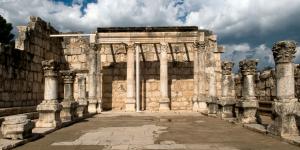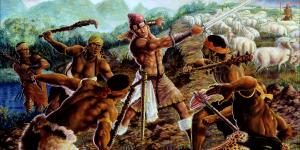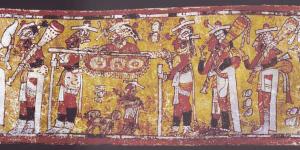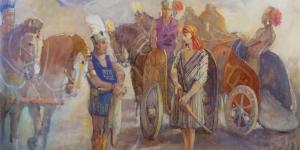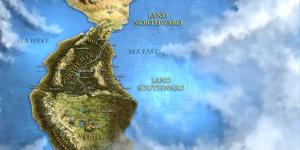You are here
Gospel Doctrine Lesson #25: They Taught With Power and Authority of God

Scripture Block
Alma 17-22
To inspire class members to follow the example of the sons of Mosiah by sharing the gospel and ministering to others.
Lesson Manual
KnoWhys

Why Was Abish Mentioned by Name?
Alma 19:16
Multimedia
Video: BYUtv Discussions on the Book of Mormon: Alma 17-20. Available at byutv.org
Video: Interpreter Scripture Roundtable 169: Book of Mormon Gospel Doctrine Lesson 25.
Chart 30: "Flashbacks in the Book of Alma," in Charting the Book of Mormon.
Chart 32: "Nephite and Lamanite Kings," in Charting the Book of Mormon.
Chart 108: "Women in the Book of Mormon," in Charting the Book of Mormon.
Chart 109: "Missionary Work," in Charting the Book of Mormon.
Chart 152: "Journeys Indicating Distances," in Charting the Book of Mormon.
Chart 158: "From Nephi to Zarahemla: The Missionary Journeys of Mosiah's Sons," in Charting the Book of Mormon.
Image: Defending the Flocks by Brian C. Hales.
Image: Ammon, Son of Mosiah by Jody Livingston
Image: Ammon 2, Son of Mosiah by James Fullmer.
Image: Ammon Defends the Flocks of King Lamoni by Arnold Friberg.
Image: King Lamoni by James Fullmer.
Image: Lamoni's Wife by James Fullmer.
Image: Lamoni's Father by James Fullmer.
Image: Abish by James Fullmer.
Articles
Alma 17
Bruce H. Yerman, "Ammon and the Mesoamerican Custom of Smiting Off Arms," Journal of Book of Mormon Studies 8, no. 1 (1999): 44–47, 78–79.
Ammon, a Nephite missionary who chose to serve a Lamanite king as his servant, gained fame by cutting off the arms of the king’s enemies. The practice of smiting off arms of enemies as trophies fits a cultural pattern known among the later Aztecs and Maya in pre-Spanish Mesoamerica.
John M. Lundquist and John W. Welch, "Ammon and Cutting Off the Arms of Enemies," in Reexploring the Book of Mormon. Edited by John W. Welch. Provo, UT: FARMS, 1992.
The practice of cutting off arms or other body parts of enemies, specifically as a testimony of the conquest of victims, is attested in the Ancient Near East. They did this to obtain accurate counts of the dead, to inspire fear in their enemies, and to reward soldiers based on their number of defeated warriors.
Hugh Nibley, "Teachings of the Book of Mormon, Lecture 51: Alma 17-19," Teachings of the Book of Mormon, Semester 2.
In proceedings of his Book of Mormon class, Nibley discusses the story of Ammon, the son of Mosiah. He provides a verse by verse commentary, and expounds on the historical and cultural context of the story.
S. Kent Brown, "Sojourn, Dwell, and Stay: Terms of Servitude," in From Jerusalem to Zarahemla: Literary and Historical Studies of the Book of Mormon. Provo, UT: Religious Studies Center, Brigham Young University 1998, 55-74.
Two accounts employ terms whose Hebrew roots point to service relationships. The first consists of the desert crossing of Lehi’s party, hinting that its members were obliged to sell themselves for protection or for food. The second, the service of Amnion in King Lamoni’s court, also uses expressions of servitude when describing the interaction of these two princes. Notably, such terms adhere to established biblical custom.
Paul Y. Hoskisson, "What's in a Name? Sebus," Insights 32, no. 1 (2012): 3-4.
Hoskisson proposes a possible etymology for the word Sebus as found in Alma 17. He uses semitic roots to derive a meaning related to "gathering."
Matthew L. Bowen, "Father is a Man: The Remarkable Mention of the name Abish in Alma 19:16 and Its Narrative Context," Interpreter: A Journal of Mormon Scripture 14 (2015): 77-93.
The mention of “Abish” and a “remarkable vision of her father” (Alma 19:16) is itself remarkable, since women and servants are rarely named in the Book of Mormon text. As a Hebrew/Lehite name, “Abish” suggests the meaning “Father is a man." The wordplay on “Abish” thus contributes thematically to the narrative’s presentation of Ammon’s typological ministrations among the Lamanites as a “man” endowed with great power, which helped the Lamanites understand the concept of “the Great Spirit” (Yahweh) becoming “man.” Moreover, this wordplay accords with the consistent Book of Mormon doctrine that the “very Eternal Father” would (and did) condescend to become “man” and Suffering Servant.
Val Larsen, "In His Footsteps: Ammon 1 and Ammon 2," Interpreter: A Journal of Mormon Scripture 3 (2013): 85-113.
This article focuses on parallel narratives that feature Ammon1 and Ammon2, with special attention to the allegorical account of Ammon2 at the waters of Sebus. To fully comprehend the power of the testimony of Christ that Mormon communicates in his Ammon narratives, readers must glean from textual details an understanding of the social and political context in which the narratives unfold.
"Ammon," Book of Mormon Onomasticon.
Detailed etymology of the name Ammon.
"Lamoni," Book of Mormon Onomasticon.
Detailed etymology of the name Lamoni.
Alma 18
FAIR Mormon entry on "Chariots"
This article contextualizes the use of chariots in the Book of Mormon to better understand their function in society. While the mention of chariots is thought to be anachronistic to the Book of Mormon, we can find germane parallels in Mesoamerican culture.
Paul R. Cheesman, "The Wheel in Ancient America," BYU Studies 9, no. 2 (1968): 185-197.
In Alma 18:12, Amman made ready the horses and the chariots for King Lamoni. However, chariots and wheels are generally considered not to be found in pre-Columbian America. For many years, scientific investigation has failed to produce information supporting the use of the wheel in Ancient America. Lately, however, there have been some artifacts found which are of serious interest to the student in this field, which is further supported by the Book of Mormon's implied use of a wheel by pre-Columbian peoples on this continent.
FAIR Mormon entry on "Horses"
This article contextualizes the use of horses in the Book of Mormon to better understand their function in society. While the mention of horses is thought to be anachronistic to the Book of Mormon, we can find germane parallels in Mesoamerican culture. In addition, we can find explanation in the translation process and in the practice of loan shifting.
Robert R. Bennet, "Hoses in the Book of Mormon," Maxwell Institute.
Alma 18 mentions how Ammon cared for the horses of King Lamoni. This article addresses the criticism that horses should not be mentioned in the Book of Mormon. Although archaeology has traditionally asserted that horses were not found in pre-Columbian America, Bennet proposes that not only could horses have existed in the Americas, but that the presence of horses could also be explained by Joseph Smith's translation process.
"Out of the Dust," Journal of Book of Mormon Studies 10, no. 1 (2001): 76-77, 80.
Evidence suggests that ancient Mesoamericans may have had horses. Excavations have produced horse bones that archaeologists believe date to before the Spanish Conquest. The article also mentions an artifact found in Bolivia that may have characters in a Semitic script. Locals have asked for assistance in examining the piece, but it is not yet clear whether it is relevant to the Book of Mormon.
Alma 19
"Abish," Book of Mormon Onomasticon.
Detailed etymology of the name Abish.
Camille S. Williams and Donna Lee Bowen, "Ordinary People in the Book of Mormon," Ensign (January 1992).
This article uses the story of Abish to illustrate the idea that ordinary people can have substantive impact in the lives of others.
Heather B. Moore, "Abish: A Common Servant, a True Testimony," Ensign (July 2012).
Having hidden her testimony for many years, Abish finally had her moment, and she did not hesitate. The result changed hundreds of lives.
Jade Swartzberg and Shari Whyte, "Bringing Abish to Life," Ensign (June 2007).
One small Book of Mormon story has made a big difference in the lives of the youth of Silverdale, Washington.
Taylor Halverson, "Evidences for the Book of Mormon: Why the missionary zeal of Abish?," Deseret News (June 7, 2015).
In this short piece, Taylor Halverson expounds on the story of Abish and how her faith fueled her zeal for missionary work.
Additional Lesson Guides
LDS Living Gospel Doctrine Lesson #25
Meridian Magazine Gospel Doctrine Lesson #25
RSC Gospel Doctrine Lesson #25
GospelDoctrine.com Alma 17, Alma 18, Alma 19, Alma 20
Ben Spackman on Patheos Lesson #25
Monte Shelley Gospel Doctrine Notes Lesson #25
Joel's Monastery Blog Gospel Doctrine Lesson #25

